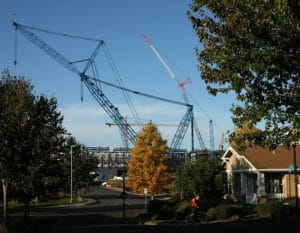Driving around the Rose City, it’s easy to surmise that construction is up. According to Barry and Associates, 9,300 apartments have been built in the Portland area since 2013. And more than 20,000 more units have been proposed or are currently under construction. Any thriving urban landscape is perpetually changing, and Portland’s new edifices bode well for our city’s economic health. But how does all this construction affect city trees?
Salem residents are asking that question about parking lot construction at the Salem Hospital. Neighbors say the hospital is violating Land Use requirements for a scaled-back parking lot. Their concern stems from the hospital’s action of clearing an 8 ½ acre property, and cutting down 32 trees in the process. Protective orange netting has been placed around remaining trees, but much of the netting is placed within the trees’ drip zones and critical root zones. That means heavy equipment is rolling over the trees roots, potentially causing lasting damage.
To appreciate why this is problematic, let’s dive into a bit of arboreal biology. Picture a tree like a wine glass; the cup is the branches and leaves, while the foot of the wine glass represents the tree’s drip line—where the branches drop water into the underlying soil. Meanwhile, the tree’s roots can extend far beyond the drip line. An older tree’s critical root radius may be double that of its drip line radius.
When heavy equipment is parked or driven over critical root zones, underlying soil is compacted, and air, moisture, and nutrients are less able to reach the tree’s roots. Some species are more sensitive to root compaction than others. White pines are very sensitive to this problem, while river birches are more tolerant.
This is only one of several ways that construction work can damage trees.
 Construction: Negative Impacts on Trees
Construction: Negative Impacts on Trees
• Root cutting may occur when excavators rip through the soil within a tree’s critical root radius.
• Soil compaction can stem from heavy construction equipment and supplies being piled beneath trees’ drip zones. Compacted soils pose other threats; for one thing, compacted soil cannot absorb as much water, and will be far more prone to flooding.
• Smothering roots by adding more soil can cause the tree equivalent of suffocation. Most of a tree’s nutrient absorption happens within the first foot of soil. Adding as little as an inch or two of extra soil can have a significant negative impact on tree absorption.
• Trunk and crown injuries may happen when construction equipment tears up bark or branches.
• Removal of surrounding trees may leave standing trees more vulnerable to sun, wind, and ice damage.
As Portland arborists, we know how much Portlanders love their trees! If you’re a homeowner who’s planning a remodel, have no fear. Our Portland certified arborists are happy to visit your site and provide professional recommendations on how to best protect beloved trees. When seeking to protect trees against construction, Portland tree services (including Urban Forest Pros) would recommend taking the following steps:
1. Plan with a professional arborist. Discuss suggested grade changes (which could suffocate roots), trenches (which could sever roots) and routes for construction machinery (which could compact soil).
2. Boost tree health prior to construction. The healthier that your trees are before construction stress, the more likely they are to survive remodeling work. Work with your arborist to improve soil health and fertilize as needed.
3. Require contractors to install barriers around trees that will be preserved. Team up with your arborist to ensure that these barriers are properly placed at or beyond the drip line, to protect trees’ roots. To add bite to your bark, include fines for violating tree barriers in your written construction specs. Include similar language and priorities when working with any landscaping crews once construction is complete.
4. Layer wood bark mulch over root zones that cannot be included within protective barriers. Six to twelve inches of mulch can help minimize compaction. Note: Be sure to remove mulch as soon as possible, as it can limit tree nutrient uptake if left in place too long.
5. Keep an eye on tree health during construction. Regularly visit the construction site to see that trees are doing well. Consistently water the protected root zones of your trees during construction to avoid water stress. Ongoing observation will allow you to quickly spot any damage, photograph it, and immediately notify the contractor of written agreement violations. During your visits, also check that protective barriers are still in place as originally set.
6. Arrange for post-construction assessment of tree health. After the remodeling project is complete, arrange another visit with your UFP arborist. He or she can spot any new damage and provide treatment to keep your trees healthy.
The City of Portland has legislation in place to protect trees and other landscaping during commercial construction. Homeowners can review those guidelines for additional construction recommendations. Finally, we’re always happy to provide information on protecting trees from construction—just call us!
This post first appeared on https://www.urbanforestprofessionals.com